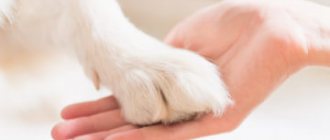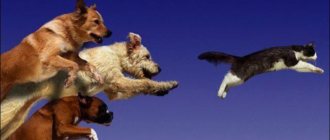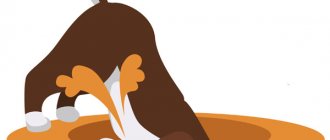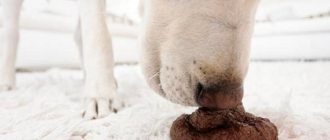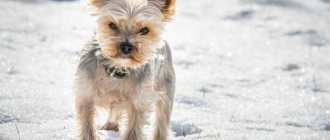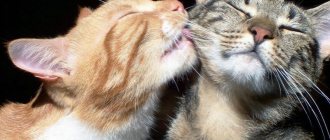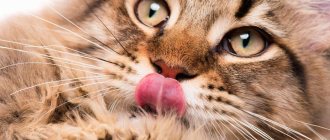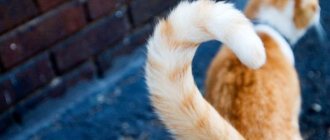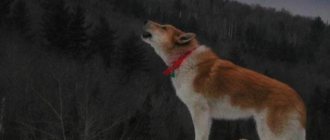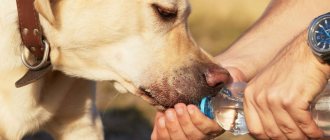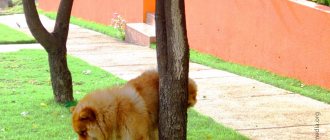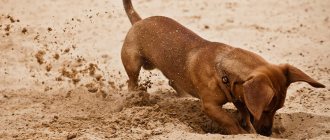In people, nail biting is considered a bad habit that is mental in nature and requires correction. Usually, for this it is recommended to visit a psychologist, who will find out the roots of the problem. But why a dog bites its claws, and what this behavior may be associated with, few people know, except perhaps veterinarians. Indeed, should the owner worry if his four-legged pet begins to regularly damage his own claws? And when can you not do without professional help?
How to help a dog
Often, owners who ask questions: “Why does a dog chew its paws, what to do in such cases?” explain their dog’s behavior as a habit or character trait, so they are in no hurry to take their pet to the veterinarian. Or, which is also not a good idea, wanting to help a dog get rid of itching in a certain area of the skin, they use “human” drugs. Self-medication is dangerous and can cause a lot of side effects. Remember that negligent attitude towards the health of your four-legged pet is fraught with serious consequences and complications.
Briefly about the main thing
- Dogs lick their back and front paws for hygienic purposes. In this way they get rid of dirt and objects left between the pads after walks.
- If the procedure becomes intrusive, severe scratching, redness, signs of hair loss and bruising appear on the limbs, you should contact a veterinarian.
- The main reasons why a dog chews its paws are neurosis, allergies, mechanical damage to the pads, infection, and exposure to reagents.
- For prevention, you should wash your pet after every walk, remove excess hair and trim its nails. In winter, wear boots or use protective wax when walking.
Have you ever experienced your dog chewing his paws? Share in the comments what to do in such a situation, how to help your pet.
Did you like the article? Share it with your friends on social media. networks. This will help them get useful information and support our project.
Preventive measures - against diseases and injuries to claws
Preventing the disease is a simple task if you pay due attention to it. Experienced dog breeders have an established system that helps them maintain the health of their four-legged friend. First of all, we are talking about the daily routine and mandatory procedures that a pet is accustomed to from puppyhood:
- Nail trimming . Sooner or later, all animals require this event, including those leading an active lifestyle - those who work and spend a lot of time on the training ground. Even if the dog’s claws wear down naturally, additional trimming may be necessary in the winter, when the pet is forced to rest, during the bitch’s pregnancy and other situations when the animal’s activity decreases. The guillotine nail clipper should be used as soon as the plates begin to reach the ground. It is advisable to entrust the first procedure to a professional - he will tell you the acceptable limit and show how to cut the claw correctly so as not to damage it.
- Washing paws . The dog's paws should be washed after every walk, regardless of weather conditions. It is better to do this with cool or lukewarm water. Sometimes this procedure can be replaced by wiping the limbs with a damp cloth. For an untrained pet, this event can cause anxiety and irritation, especially when it comes to the hind legs. If the dog has not been trained from an early age, you can initially use reward in the form of a treat - this will create a pleasant association in the dog.
- If required, you need to take care of shoes for your dog . Representatives of non-working breeds, whose paw pads are covered with delicate skin, are recommended to wear special boots before walking. They protect your pet’s limbs not only from cold and moisture, but also from the effects of snow, sand, salt, and reagents that get on the claws and feet, causing chemical burns or cold injuries.
- Sometimes special care is needed . Your pet's pads should be inspected after every walk, but in some cases special procedures are not necessary. For example, some dogs in the heat require additional moisturizing of the skin on their paws - at high air temperatures, the animal can develop dehydration, which will also negatively affect the condition of the coat, skin and claws. For these purposes, you can use cosmetic Vaseline, baby cream or milk, which soften the tissue, thereby reducing the risk of possible cracking of the surface.
- Proper, balanced nutrition . As you know, if a dog is poorly fed, its coat becomes dull and sparse, and its nails begin to flake and break. It is important that your pet’s diet consists of healthy, fresh foods, and when feeding ready-made food, you should choose a high-quality premium or super-premium product.
Infections, fungal infections and other ailments
When something hurts or causes discomfort, only one desire arises - to stop it by any means. A person takes pills or goes to the doctor, a dog licks or chews the “causal” area.
The allergy causes itching in soft areas of the skin, including between the fingers. Since the dog cannot scratch its paw with its other paw, it uses its teeth. Usually, the four-legged itch very much and often, clearly making it clear that a specific place is bothering him.
Note! A dog may consciously bite its claws if it has severe vitamin deficiency.
Infectious lesion - on a walk, the pet can pick up a splinter and behave absolutely normally for several days. The infection process may not appear for several more days, at a time when the dog is already experiencing discomfort. In this case, the pet will lick its paws and claws, trying to soothe the pain. Obvious swelling, suppuration, abscess - these are already consequences.
Note! After walking, blades of grass, small branches or rolled snow may get stuck in the fur between the fingers and the dog will chew out the foreign object.
Fungal infection - leads to diseases of the claws , their separation and severe itching in the affected area. Affected claws change color (lighten), sometimes they have a sweetish smell.
Symmetrical lupoid or lupus onychodystrophy (SLO) is a disease characteristic of large dogs. The causes of the disease have not yet been established, but it is usually classified as autoimmune. The disease is expressed by the sequential rejection of all nail plates from the claw bed (including on the dewclaws). When the first toe is affected, many owners and veterinarians confuse TLS with injury. Claws that are not completely peeled off cause pain when walking and the dog literally tears off the nail plates with his teeth.
How to recognize the problem?
Caring for your paws is a natural hygiene procedure for any dog. A deviation is considered if the desire to lick the limbs becomes obsessive, the animal often gnaws the pads for a long time. To detect the problem, you should inspect your dog's paws regularly. They should be free of persistent dirt, signs of injury and other mechanical damage. The following signs are unacceptable:
- presence of blood;
- inflamed and weeping areas of the skin;
- dry crusts on the pads;
- traces of alopecia (hair loss);
- change in dog behavior;
- refusal of food, games.
Be sure to pay attention to any deviations in your pet’s usual behavior. You should consult a doctor if your dog becomes aggressive or apathetic (when he chews), refuses food and even his favorite treats. The problem can be especially dangerous if the pet begins to growl and grin, and does not allow him to approach him during the next licking of his paws.
Inspection of a dog's paws should be done carefully. Even the slightest touch of the paws can be painful and uncomfortable for the dog. You need to be careful when touching the paws of older pets - the problem may arise due to age-related joint diseases.
Ringworm
Ringworm is a fungal infection that spreads easily through contact with contaminated soil or animals. It is usually found on the paws, as well as the head, ears and limbs of dogs.
Hair loss and redness of the skin may occur, but some animals may have ringworm and not show any signs.
Topical creams, shampoos, and sauces can be helpful in getting rid of ringworm.
Long-haired animals may need to have their hair shaved to prevent re-infestation. This should only be done with pet clippers and you should use a guide comb to avoid pressing too close to the skin.
Nail trimming
Unlike cats, dogs cannot shorten their toenails on their own - they have a dense structure, a large number of nerve endings and blood vessels. Long claws cause a lot of discomfort, so the animal tries in every possible way to get rid of them - it starts gnawing and licking its paws. It is important to get a haircut every 1-2 months, to get used to the procedure. Step-by-step algorithm for processing claws:
- Secure the dog in a standing or lying position. If necessary, wear a muzzle.
- Pull back the fur and use a flashlight to illuminate the claw (bright light allows you to see the vessels inside).
- Using special pliers, cut off the edge of the nail bed (collagen layer) - it has no nerves or capillaries.
If bleeding does occur, apply a cotton pad soaked in hydrogen peroxide. If there is a sharp cut left, polish it with a nail file. During the procedure, you should not make sudden movements and praise the dog after each nail trimmed. At the end of the work, be sure to treat your pet with a treat to associate the haircut with positive emotions. Manipulation can be combined with shortening the hair, which is especially important for long-haired breeds and hunting dogs.
Allergy
If your dog's paws are itchy, it could be due to an allergy. Allergies are common and can be caused by the environment, food, or an irritant that comes into contact with your dog's skin.
Redness, dark pigmentation, or brown spots on the paws from constant licking may be signs of an allergy. Washing or drying your dog's paws after going outside will reduce the number of allergens on your dog's skin.
Topical hydrocortisone creams or sprays sold for dogs can temporarily relieve the itching, but more intense licking requires systemic treatment (prescription medications that affect the entire body).
Diagnostics
At an appointment with a veterinarian, an external examination takes place. The veterinarian examines the general condition of the animal, the dog’s oral cavity, and carefully examines the wounds. If matted fur or abnormal nail growth occurs, the animal is sent to a groomer to correct the problems.
If there are no visible injuries, but the animal continues to bite its paws, an in-depth examination is carried out. The doctor takes:
- scrapings to determine allergic reactions or parasites;
- blood chemistry;
- cal.
The question of treatment will arise after receiving the results.
Paw care after a walk
Proper care of your pet after a walk is a basic method of prevention to prevent the dog from gnawing its paws. Allows you to avoid complications from mechanical damage (wounds, abrasions, splinters), infections and the consequences of contact with reagents in winter.
After each visit to the street, paws should be washed with clean running water, and if necessary, use a special shampoo for dogs. Recently, paw washers have become very popular - small jars with brushes inside that are easy to use for cleaning dirt for any breed. After hygiene procedures, carefully examine the paw pads and fur. There should be no traces of dirt, blood or mechanical objects.
Main reasons
There are several reasons why a dog may begin to constantly chew and bite its back legs. Often this problem is caused by physiological factors and non-compliance with maintenance rules:
- poor-quality care - the owner does not clean the dog after walks, does not trim its nails regularly;
- contact with reagents that are sprinkled on ice in winter;
- unbalanced diet, lack of sufficient protein, vitamins and minerals in the diet;
- mechanical damage to the skin, abrasions and splinters.
These difficulties can be easily resolved on your own, without visiting a veterinary clinic. It is enough to monitor the pet’s condition and conduct regular examinations. The dog may begin to actively lick and chew its paws due to illness. A similar symptom is characteristic of the following diseases:
Read also: Do sphinxes have mustaches?
- food or contact allergies;
- neurosis (against the background of it, not only the paws are gnawing, but also the tail);
- subcutaneous mite, demodicosis;
- fungal infection;
- circulatory disorders;
- joint diseases, displacement of spinal discs;
- atopic dermatitis.
To accurately determine the cause, high-quality diagnostics are recommended. That is why it is important to contact a veterinarian in a timely manner and undergo a routine examination at least twice a year. If a dog bites its paws for a long time, it can result in tissue infection, inflammation and even necrosis.
How to stop a puppy from biting: ov
The easiest way is to wean a kitten from using its teeth. Kids are receptive: what they learned in childhood they will carry with them throughout their lives.
If a dog bites your hands before the age of six months, use the methods listed below.
Punish with hand
The statement that punishment can only be carried out with objects, because... the kitten will be afraid of hands - nonsense. The parent dog licks the puppies, chews their food and, with the same mouth, scolds the presumptuous mischief-makers. There has never been a single puppy that was afraid of its mother's mouth.
How to do it is another matter. Hitting is prohibited. You can stop a little prankster from grabbing hands:
- clicking the nose or ears;
- spanking (lightly!) on the rump: you can’t hit the butt, dogs don’t have gluteal muscles, and there are kidneys in the area of the seat;
- sharply grabbing and pinching with your palm, imitating a bite.
When your baby bites your arms or legs, you should not break down. This is not how you wean your pet. The punishment is as painless as possible - pinching and spanking are symbolic, they humiliate more than they bring physical discomfort.
Calm down
The playing kitten is cut off:
- sending to the place;
- giving commands of prohibition (“No”, “Fu”) or restraint (“Stand”, “Sit”, “Lie down”);
- when pushing out of the room, they make a prohibiting gesture and, walking towards the pet, push him into another room;
- ignoring - they don’t talk to the kitten, don’t look him in the eye, turn their side or back to him.
Using the same methods, you can wean your dog from jumping when meeting people.
What to do
If the pathology is associated with skin irritation or overgrown nails, the clinic will help you trim your nails and remove excess hair between your toes.
A more in-depth examination of your pet may be required. For example, if the skin on the fingers of a shepherd dog becomes numb, the lesion is associated with impaired blood flow or displacement of the vertebrae.
If physical causes have been ruled out and the doctor suspects a neurotic disorder, it will be necessary to analyze what could have affected the pet and take measures to calm the animal.
Clinical picture
On the affected areas of the paws, there is most often a papular-pustular rash (small red pimples and pustules), erythema (redness) of the skin, peeling, there may be small scratches and hairless areas. Sometimes single or multiple “nodules” can form in the interdigital space - dense painful formations, which after some time open with the release of pus. Lesions can occur on one limb or on several at once. The skin of the interdigital spaces may be affected both from the side of the pads and from the opposite side.
What can be done in such a situation
After discovering a problem, every owner wants to know what to do if their dog bites its nails. First of all, it is necessary to eliminate the cause of this behavior, if it is obvious. To do this, you first need to check the length and condition of the claws. In most cases, it is enough to simply trim the nails with a special nail clipper for dogs. At the same time, care must be taken not to shorten them in such a way that a nerve or vessel will be affected. It is enough to trim them at the level of the fingertip. If the edges are too sharp, they need to be carefully filed.
Dirty paws need to be washed thoroughly, removing any dirt, sand or gravel that has accumulated between the toes. With high-quality regular washing, the risk of inflammation from street pollution becomes much less. The risk of skin allergies is also reduced.
If your dog's claws grow too long due to an unhealthy lifestyle, increase the time and frequency of his exercise, and drive the animal on asphalt and hard ground more often and for longer. Entertain a bored dog, buy him toys and be around him more. For chronic stress, determine the cause - it could be noise, a small child who is tormenting the dog, an uncomfortable place to sleep, a rude attitude, poor health, and much more.
If a dog bites its claws due to health problems, there can only be one way out - a visit to the veterinary clinic. Only a doctor can accurately diagnose and prescribe the necessary treatment.
Watch the behavior of your four-legged friend, it can tell a lot about his mood and well-being.
Treatment and treatment at home
In the early stages, when there is no severe tissue damage in the area of the pads, treatment can be carried out at home. The main rule is high-quality care for your pet’s paws, as well as timely treatment when gnawing. Algorithm of actions:
- Carefully examine the area that the dog is licking (pads, fur on the bend of the limb, fingers).
- Remove any visible dirt with a cotton pad soaked in clean water.
- Trim off excess hair and shorten the length of nails if possible.
- Treat the skin with any antiseptic solution (Miramistin, Chlorhexidine, Furacilin).
- If there is bleeding, apply a cotton pad with hydrogen peroxide and secure it with a special adhesive bandage. It is recommended to additionally wear a muzzle or an Elizabethan collar.
It is recommended to carry out treatment after each walk, at least 2 times a day. If there are no visible improvements within 2-3 days, then contact a veterinary clinic.
Tags
Why does a dog gnaw Why a dog gnaws dog owners is their dog gnaws causing a dog to gnaw which dog can his dog gnaws keeping a dog. cause a dog pain a dog or can gnaw on claws will gnaw on everything can gnaw on a claw begins to gnaw on a claw as causes the main reasons can cases cause excessive and cause a dog not become a cause Sometimes the cause of the strange will establish the reason for this
article constantly content of your vitamins neurosis pet share similar more often the beginning is the owner in comments and the site published
